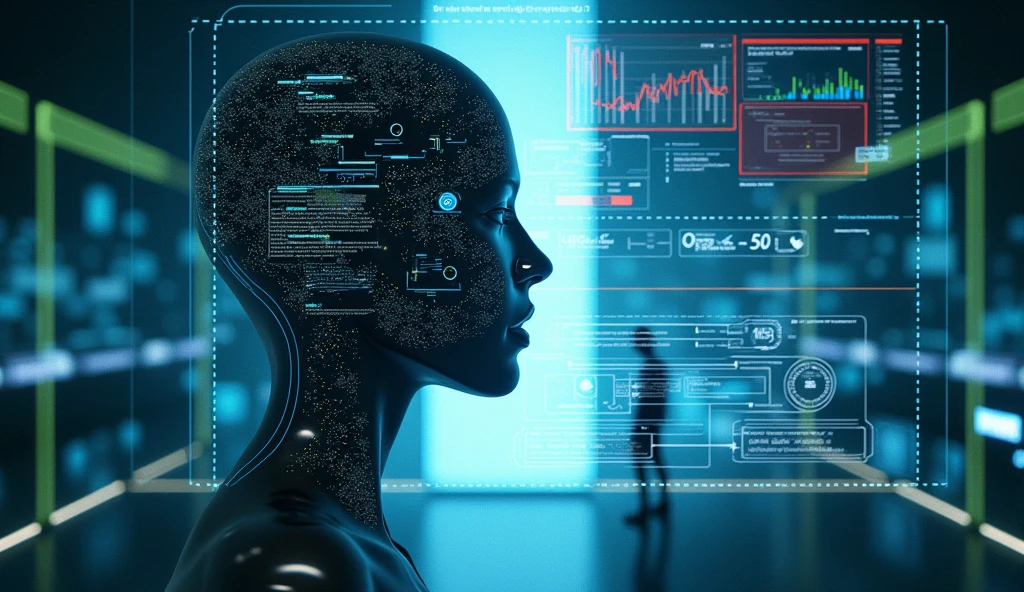Introduction to AI Algorithms
Artificial Intelligence (AI) algorithms form the backbone of machine learning and data processing systems, enabling computers to process information and make decisions with remarkable accuracy. At their core, AI algorithms consist of a set of rules or procedures designed to solve specific problems by analyzing data. These algorithms are crucial for executing tasks ranging from simple calculations to complex predictive analytics, all while learning from observed patterns.
The fundamental concept behind AI algorithms is data manipulation. By ingesting large datasets, these algorithms can identify trends and patterns that may not be immediately apparent to human analysts. For instance, supervised learning algorithms utilize labeled datasets to predict outcomes based on input variables, while unsupervised learning algorithms seek to identify hidden structures within unlabeled data. Both types demonstrate the versatile nature of AI algorithms in adapting to different scenarios and objectives.
In addition to their ability to learn from data, AI algorithms are instrumental in decision-making processes across numerous fields. For example, in healthcare, algorithms analyze patient data to suggest diagnoses or treatment plans. In finance, they evaluate market trends to inform investment strategies. Through their application, the importance of AI algorithms becomes evident, as they not only enhance efficiency but also contribute to improving accuracy in critical sectors.
Understanding the underlying principles of AI algorithms is essential for grasping their functionality and potential implications in various industries. This knowledge prepares individuals to explore the diverse types of algorithms, such as neural networks, decision trees, and support vector machines, each with unique capabilities and applications. By examining these algorithms, readers can better appreciate how they shape the future of technology and innovation.

Types of AI Algorithms
Artificial intelligence (AI) relies on various algorithms to analyze data and make predictions. Understanding the different types of AI algorithms is crucial to harnessing their full potential across diverse applications. At the forefront are supervised learning algorithms, which require labeled data to train the model. This category is utilized extensively in tasks such as image recognition and spam detection, where the algorithm learns to map input data to the correct output via a training dataset. For instance, a model trained on an extensive collection of labeled images can identify objects in new, unlabeled images, demonstrating the significant utility of supervised learning.
Unsupervised learning algorithms operate differently, as they work with unlabeled data. These algorithms are designed to find patterns or groupings within the data, enabling several applications such as customer segmentation and anomaly detection. For example, clustering algorithms like K-means can categorize users based on purchasing behavior, allowing businesses to tailor marketing strategies effectively.
Reinforcement learning represents another fascinating branch of AI algorithms. This method involves training an agent through a system of rewards and penalties, effectively learning optimal actions in a given environment. An illustrative application is seen in game playing, where AI agents learn to outperform human players by continuously adjusting their strategies based on feedback from their actions.
Lastly, deep learning algorithms, a subset of machine learning, leverage neural networks to process vast amounts of data. These algorithms are pivotal in complex tasks such as natural language processing and image generation.
For instance, convolutional neural networks (CNNs) are extensively used for recognizing patterns in images, leading to advancements in facial recognition technologies. Understanding these types of AI algorithms not only showcases their versatility but also underscores the diverse challenges they can address across various industries.
How AI Algorithms Work
AI algorithms operate through a systematic process that involves several key stages: training, validation, and testing. At the core of the algorithm’s functionality lies its ability to learn from data. The training phase is crucial, as it involves feeding the algorithm with a substantial dataset, which includes both input features and corresponding labels. This dataset must be both high-quality and of significant quantity, as it directly impacts the algorithm’s ability to generalize effectively to new, unseen data. Without adequate data, the risk of overfitting and underfitting increases, negatively influencing the model’s performance.
During the training process, machine learning models learn patterns and relationships within the data. Feature selection plays a vital role in this stage, as it involves identifying the most relevant variables to include in the model. This can significantly enhance the model’s accuracy and efficiency. Feature engineering, which entails creating new features from existing data, can also pave the way for improved predictive capabilities. Both feature selection and engineering require domain knowledge and a deep understanding of the data at hand to create a robust AI system.
Once the model has been trained, the validation phase assesses its performance using a separate validation dataset. This is crucial to ensure that the model does not simply memorize the training data but can apply its learned knowledge to new instances. After validation, the final testing phase evaluates the model’s predictive accuracy and effectiveness on another distinct dataset.
Optimization techniques, such as hyperparameter tuning and cross-validation, facilitate the enhancement of algorithm performance, addressing various computational challenges intrinsic to AI development. These techniques help refine the model to handle real-world data complexities, ultimately leading to more reliable and accurate AI systems.

Challenges and Future of AI Algorithms
The advancement of artificial intelligence (AI) algorithms presents both remarkable opportunities and significant challenges. A primary challenge lies in the presence of bias in the data used to train these algorithms. Bias can inadvertently emerge from historical data, leading to skewed outcomes that can affect decisions in sensitive areas such as hiring, lending, and law enforcement. Consequently, addressing data bias becomes critical for the ethical application of AI technologies. Researchers are increasingly focused on developing strategies to mitigate bias through improved data collection practices and algorithmic fairness frameworks.
Another challenge faced by AI algorithms is interpretability. As these algorithms become more complex, understanding their decision-making processes can become increasingly difficult. This lack of transparency can erode trust among users and stakeholders. Establishing a clearer understanding of how algorithms arrive at specific conclusions is paramount. Researchers are advocating for models that not only provide accurate predictions but are also explainable and transparent, bridging the gap between complexity and comprehensibility.
Looking towards the future, several emerging trends are poised to redefine the landscape of AI algorithms. One such development is the integration of quantum computing, which promises to significantly enhance computational capabilities and enable algorithms to solve complex problems at unprecedented speeds. Furthermore, advancements in neural networks are leading to more efficient models that can operate with less data while maintaining high accuracy. As these technologies evolve, they hold the potential to transform a variety of sectors, including healthcare, finance, and transportation.
In conclusion, while challenges such as bias and interpretability persist within AI algorithms, the future also brings exciting advancements. By addressing these challenges and embracing emerging technologies, the potential of AI algorithms can be fully realized, paving the way for innovative applications that enhance our daily lives and decision-making processes.
Conclusion
AI algorithms are the driving force behind many of the advancements in artificial intelligence, shaping the way machines process information and make decisions. Their ability to analyze data, identify patterns, and adapt to different environments has led to their widespread application across industries such as healthcare, finance, and transportation.
Despite the challenges of bias and interpretability, AI algorithms continue to evolve, offering promising opportunities for future innovation. By addressing these challenges and integrating new technologies like quantum computing, AI algorithms will play an even more crucial role in shaping the future of technology and decision-making.
FAQ: Understanding AI Algorithms
What are AI algorithms?
These are sets of rules or procedures designed to solve specific problems through data analysis. They form the basis of artificial intelligence, enabling machines to learn, adapt, and make decisions.
How do AI algorithms work?
They process large amounts of data, identify patterns, and use those patterns to make predictions or decisions. They typically go through training, validation, and testing phases to improve accuracy.
What are the different types of AI algorithms?
There are several types, including:
- Supervised learning algorithms (require labeled data)
- Unsupervised learning algorithms (work with unlabeled data)
- Reinforcement learning (learning through rewards and penalties)
- Deep learning algorithms (utilize neural networks)
What is the difference between supervised and unsupervised learning?
Supervised learning requires labeled data and aims to predict specific outcomes. Unsupervised learning works with unlabeled data, finding patterns or groupings within the data without predefined outcomes.
What is the role of data in AI algorithms?
Data is essential for AI algorithms. It provides the information needed for algorithms to learn, detect trends, and make predictions. The quality and quantity of data directly affect the algorithm’s accuracy.
How do AI algorithms improve decision-making?
AI algorithms analyze large datasets to identify patterns and trends that might not be easily visible to humans. This helps in making more informed and accurate decisions in fields like healthcare, finance, and marketing.
What are some common applications of AI algorithms?
AI algorithms are used in various industries:
- Healthcare: Diagnosing diseases, recommending treatments
- Finance: Predicting market trends, fraud detection
- Retail: Personalizing shopping experiences, inventory management
- Transportation: Autonomous driving, route optimization
What are the challenges in developing AI algorithms?
Some key challenges include:
- Data bias: Using biased data can lead to unfair outcomes.
- Interpretability: Complex algorithms can be difficult to understand and explain.
- Computational power: Some algorithms require significant computing resources.
What is the future of AI algorithms?
The future holds exciting possibilities, including advancements in quantum computing, which could greatly speed up complex problem-solving. AI algorithms will also become more efficient and require less data for accurate predictions.
How do AI algorithms impact everyday life?
AI algorithms enhance daily experiences through technologies like virtual assistants, personalized recommendations, smart home devices, and even fraud detection in online transactions.
See also: How does artificial intelligence learn.



